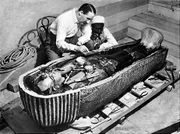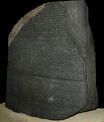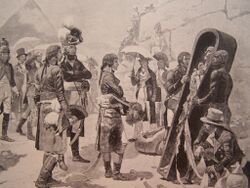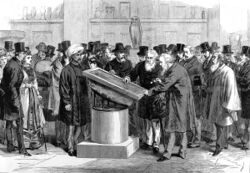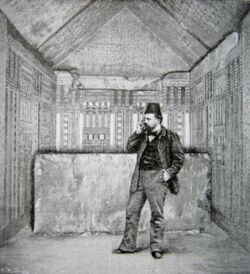علوم المصريات
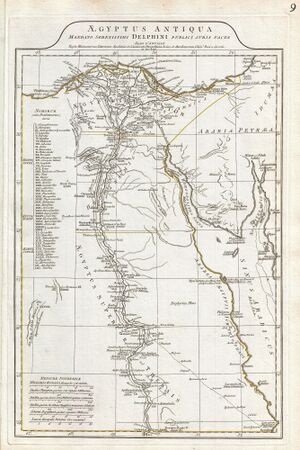 Jean-Baptiste Bourguignon d'Anville's 1765 map of Ancient Egypt was a significant advance in the cartography of the subject, allowing readers to understand ancient and modern sites more clearly than previously. It was the primary map used in the 1809–1829 Description de l'Égypte.[1] |
| ||||||||||||||||
علم المصريات Egyptology هو علم يختص بدراسة مصر القديمة و تاريخ مصر وهو أهم جزء من تاريخ العالم القديم بشكل عام. و علم المصريات هو دراسة مصر الفرعونية من بداية الثقافة المصرية (ما قبل 4500 قبل الميلاد) إلى الفتح العربي (641 بعد الميلاد). بدأ علم المصريات منذ اكتشاف حجر رشيد (1799) وإصدار كتاب وصف مصر (1809-1828) لمجموعة من العلماء الذين صحبوا نابليون بونابرت في حملته الفرنسية على مصر. في عام 1880، أحدث سير ويليام ماثيو فلندرز پتري، عالم المصريات الإنجليزي، ثورةً كبيرة فيما يخص الآثار المصرية أبرزها وجود أصول مصرية منذ عام 4500 قبل الميلاد. ولقد زاد اكتشاف مقبرة توت عنخ آمون في عام 1922 من الوعي العام بالمصريات. في عام 1975، اجتمع المؤتمر الدولي الأول حول المصريات في القاهرة. ويظل هناك الكثير من المواقع التي لم يتم اكتشافها بعد.
. . . . . . . . . . . . . . . . . . . . . . . . . . . . . . . . . . . . . . . . . . . . . . . . . . . . . . . . . . . . . . . . . . . . . . . . . . . . . . . . . . . . . . . . . . . . . . . . . . . . . . . . . . . . . . . . . . . . . . . . . . . . . . . . . . . . . . . . . . . . . . . . . . . . . . . . . . . . . . . . . . . . . . . .
التاريخ
المستكشفون الأوائل
The first explorers were the ancient Egyptians themselves. Prompted by a dream he had, Thutmose IV restored the Sphinx and had the dream that inspired the restoration carved on the famous Dream Stele. Less than two centuries later, Prince Khaemweset, fourth son of Ramesses II, would gain fame for identifying and restoring historic buildings, tombs and temples, including pyramids; and has subsequently been described as the first Egyptologist.[2]
الفترة اليونانية-الرومانية
| المؤلفون القدماء عن مصر | ||
|---|---|---|
| العصر اليوناني القديم | ||
| هيرودوت V в. до н. э. |
Книга II. Евтерпа[3] Книга III. Талия[4] |
«История» باليونانية قديمة: Ἱστορίαι |
| هكاتي من أبديرا IV в. до н. э. |
شظايا | «إگيپتياكا» † باليونانية قديمة: Ἀιγυπτιακά |
| ديودورس الصقلي I в. до н. э. |
Книга I [5][6][7][8], Книга XVI[9], Книга XVII. |
«Историческая библиотека» باليونانية قديمة: Βιβλιοθήκη ἱστορική |
| العصر الروماني | ||
| أميانوس مارسلينوس IV в. |
Книга XVII, Гл. 4 (1-23)[10] Книга XXII, Гл. 15-16[11] |
«Деяния в тридцати одной книге» [] Error: {{Lang-xx}}: no text (help)Rerum gestarum libri XXXI |
| المؤلفون القروسطيون عن مصر | ||
Some of the first historical accounts of Egypt were given by Herodotus, Strabo, Diodorus Siculus and the largely lost work of Manetho, an Egyptian priest, during the reign of Ptolemy I and Ptolemy II in the 3rd century BC. The Ptolemies were very interested in the work of the ancient Egyptians, and many of the Egyptian monuments, including the pyramids, were restored by them. The Ptolemies also built many new temples in the Egyptian style. The Romans also carried out restoration work in Egypt.
العصور الوسطى
hroughout the Middle Ages travelers on pilgrimages to the Holy Land would occasionally detour to visit sites in Egypt. Destinations would include Cairo and its environs, where the Holy Family was thought to have fled, and the great Pyramids, which were thought to be Joseph's Granaries, built by the Hebrew patriarch to store grain during the years of plenty. A number of their accounts (Itineraria) have survived and offer insights into conditions in their respective time periods.[12]
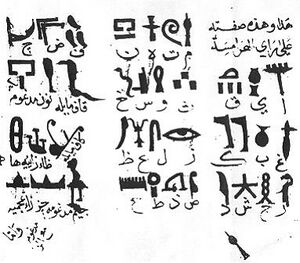
Abdul Latif al-Baghdadi, a teacher at Cairo's Al-Azhar University in the 13th century, wrote detailed descriptions of ancient Egyptian monuments.[13] Similarly, the 15th-century Egyptian historian al-Maqrizi wrote detailed accounts of Egyptian antiquities.[14]
المستكشفون الأوروبيون
European exploration and travel writings of ancient Egypt commenced in the 13th century, with only occasional detours into what could be considered a scientific approach, notably by Claude Sicard, Benoît de Maillet, Frederic Louis Norden and Richard Pococke.
In the early 17th century, John Greaves measured the pyramids, having inspected the broken Obelisk of Domitian in Rome, then intended for Lord Arundel's collection in London.[15] He went on to publish the illustrated Pyramidographia in 1646.
The Jesuit scientist-priest Athanasius Kircher was perhaps the first to hint at the phonetic importance of Egyptian hieroglyphs, demonstrating Coptic as a vestige of early Egyptian, for which he is considered a founder of Egyptology.[16]
علم المصريات الحديث
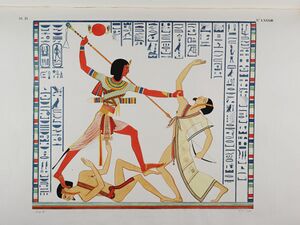
Egyptology's modern history begins with the invasion of Egypt by Napoleon Bonaparte in the late 18th century. The Rosetta Stone was discovered in 1799. The study of many aspects of ancient Egypt became more scientifically oriented with the publication of Mémoires sur l'Égypte in 1800 and the more comprehensive Description de l'Egypte between 1809 and 1829. These recorded Egyptian flora, fauna, and history—making numerous ancient Egyptian source materials available to Europeans for the first time.[17] The British captured Egypt from the French and gained the Rosetta Stone in 1801, the Greek script of which was translated by 1803. In 1822, the respective Egyptian hieroglyphs were transliterated by Jean-François Champollion, marking the beginning of modern Egyptology. With increasing knowledge of Egyptian writing, the study of ancient Egypt was able to proceed with greater academic rigour. Champollion, Thomas Young and Ippolito Rosellini were some of the first Egyptologists of wide acclaim. The German Karl Richard Lepsius was an early participant in the investigations of Egypt—mapping, excavating and recording several sites.
English Egyptologist Flinders Petrie (1853–1942) introduced archaeological techniques of field preservation, recording, and excavation to the field. Many highly educated amateurs also travelled to Egypt, including women such as Harriet Martineau and Florence Nightingale. Both of these left accounts of their travels, which revealed learned familiarity with all of the latest European Egyptology.[18] Howard Carter's 1922 discovery of the tomb of 18th Dynasty King Tutankhamun brought a greater understanding of Egyptian relics and wide acclaim to the field.
In the modern era, the Ministry of State for Antiquities[19] controls excavation permits for Egyptologists to conduct their work. The field can now use geophysical methods and other applications of modern sensing techniques.
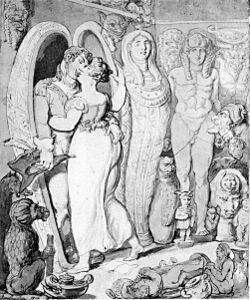
In June 2000,[20] the European Institute for Underwater Archaeology (IEASM), directed by Franck Goddio, in cooperation with the Egyptian Ministry for Antiquities discovered the ancient sunken city of Thonis-Heracleion in today's Abu Qir Bay. The statues of a colossal King and Queen are on display at the Grand Egyptian Museum. Other discovered artefacts are exhibited at the Bibliotheca Alexandrina and Alexandria National Museum (ANM). The excavations are documented through several publications[21][22]
In March 2017, the Egyptian-German team of archaeologists unearthed an eight-meter 3,000-year-old statue that included a head and a torso thought to depict Pharaoh Ramses II. According to Khaled El-Enany, the Egyptian Antiquities Minister, the statue was more likely thought to be King Psammetich I. Excavators also revealed an 80 cm-long part of a limestone statue of Pharaoh Seti II while excavating the site.[23][24][25][26][27]
In August 2017, archaeologists from the Ministry of Antiquities announced the discovery of five mud-brick tombs at Bir esh-Shaghala, dating back nearly 2,000 years. Researchers also revealed worn masks gilded with gold, several large jars and a piece of pottery with unsolved ancient Egyptian writing on it.[28][29][30]
In November 2017 (25 October 2000), the Egyptian mission in cooperation with the European Institute for Underwater Archaeology announced the discovery of 2,000-year-old three sunken shipwrecks dated back to the Roman Era in Alexandria's Abu Qir Bay.[31][32]
The sunken cargo included a royal head of crystal perhaps belong to the commander of the Roman armies of “Antonio”, three gold coins from the era of Emperor Octavius Augustus, large wooden planks and pottery vessels.[33]
In April 2018, the Egyptian Ministry of Antiquities announced the discovery of the head of the bust of Roman Emperor Marcus Aurelius at the Temple of Kom Ombo in Aswan during work to protect the site from groundwater.[34][35]
In April 2018, the Egyptian Ministry of Antiquities announced the discovery of the shrine of god Osiris- Ptah Neb, dating back to the 25th dynasty in the Temple of Karnak in Luxor. According to archaeologist Essam Nagy, the material remains from the area contained clay pots, the lower part of a sitting statue and part of a stone panel showing an offering table filled with a sheep and a goose which were the symbols of the god Amun.[36]
In July 2018, German-Egyptian researchers’ team head by Ramadan Badry Hussein of the University of Tübingen reported the discovery of an extremely rare gilded burial mask that probably dates from the Saite-Persian period in a partly damaged wooden coffin in Saqqara. The last time a similar mask was found was in 1939. The eyes were covered with obsidian, calcite, and black hued gemstone possibly onyx. "The finding of this mask could be called a sensation. Very few masks of precious metal have been preserved to the present day, because the tombs of most Ancient Egyptian dignitaries were looted in ancient times." said Hussein.[37][38]
In July 2018, archaeologists led by Zeinab Hashish announced the discovery of a 2,000-year-old 30-ton black granite sarcophagus in Alexandria. It contained three damaged skeletons in red-brown sewage water. According to archaeologist Mostafa Waziri, the skeletons looked like a family burial with a middle-aged woman and two men. Researchers also revealed a small gold artifact and three thin sheets of gold.[39][40][41]
In September 2018, a sandstone sphinx statue was discovered at the temple of Kom Ombo. The statue, measuring approximately 28 cm (11 in) in width and 38 cm (15 in) in height, likely dates to the Ptolemaic Dynasty.[42][43][44]
In September 2018, several dozen cache of mummies dating 2,000 years back were found in Saqqara by a team of Polish archaeologists led by Kamil Kuraszkiewicz from the Faculty of Oriental Studies of the University of Warsaw.[45]
In November 2018, an Egyptian archaeological mission located seven ancient Egyptian tombs at the ancient necropolis of Saqqara containing a collection of scarab and cat mummies dating back to the Fifth and Sixth Dynasties. Three of the tombs were used for cats, some dating back more than 6,000 years, while one of four other sarcophagi was unsealed. With the remains of cat mummies were unearthed gilded and 100 wooden statues of cats and one in bronze dedicated to the cat goddess Bastet. In addition, funerary items dating back to the 12th Dynasty were found besides the skeletal remains of cats.[46][47][48]
In mid-December 2018, the Egyptian government announced the discovery at Saqqara of a previously unknown 4,400-year-old tomb, containing paintings and more than fifty sculptures. It belongs to Wahtye, a high-ranking priest who served under King Neferirkare Kakai during the Fifth Dynasty. The tomb also contains four shafts that lead to a sarcophagus below.[49]
According to the Al-Ahram, in January 2019, archaeologists headed by Mostafa Waziri revealed a collection of 20 tombs dated back to the Second Intermediate Period in Kom Al-Khelgan. The burials contained the remains of animals, amulets, and scarabs carved from faience, round and oval pots with handholds, flint knives, broken and burned pottery. All burials included skulls and skeletons in the bending position and were not very well-preserved.[50][51]
In April 2019, archaeologists discovered 35 mummified remains of Egyptians in a tomb in Aswan. Italian archaeologist Patrizia Piacentini, professor of Egyptology at the University of Milan, and Khaled El-Enany, the Egyptian minister of antiquities reported that the tomb where the remains of ancient men, women and children were found, dates back to the Greco-Roman period between 332 BC and 395 AD. While the findings assumed belonging to a mother and a child were well preserved, others had suffered major destruction. Beside the mummies, artefacts including painted funerary masks, vases of bitumen used in mummification, pottery and wooden figurines were revealed. Thanks to the hieroglyphics on the tomb, it was detected that the tomb belongs to a tradesman named Tjit.[52][53][54]
On 13 April 2019, an expedition led by a member of the Czech Institute of Egyptology, Mohamed Megahed, discovered a 4,000-year-old tomb near Egypt's Saqqara Necropolis in Saqqara. Archaeologists confirmed that the tomb belonged to an influential person named Khuwy, who lived in Egypt during the 5th Dynasty. "The L-shaped Khuwy tomb starts with a small corridor heading downwards into an antechamber and from there a larger chamber with painted reliefs depicting the tomb owner seated at an offerings table", reported Megahed. Some paintings maintained their brightness over a long time in the tomb. Mainly made of white limestone bricks, the tomb had a tunnel entrance generally typical for pyramids. Archaeologists say that there might be a connection between Khuwy and pharaoh because the mausoleum was found near the pyramid of Egyptian Pharaoh Djedkare Isesi, who ruled during that time.[55][56][57]
In July 2019, ancient granite columns and a smaller Greek temple, treasure-laden ships, along with bronze coins from the reign of Ptolemy II, pottery dating back to the third and fourth centuries BC were found at the sunken city of Heracleion. The investigations were conducted by Egyptian and European divers led by underwater archaeologist Franck Goddio. They also uncovered the ruins of the city's main temple off of Egypt's north coast.[58][59][60][61]
In September 2019, archaeologists announced the discovery of a 2,200-year-old temple believed to belong to the Ptolemy IV Philosopher of the Ptolemaic Kingdom in Kom Shakau village of Tama township. Researchers also revealed limestone walls carved with inscriptions of Hapi, the Nile god, and inscriptions with fragments of text featuring the name of Ptolemy IV.[62][63][64]
In May 2020, Egyptian-Spanish archaeological mission head by Esther Ponce uncovered a unique cemetery dating back to the 26th Dynasty (so-called the El-Sawi era) at the site of ancient Oxyrhynchus. Archaeologists found tombstones, bronze coins, small crosses, and clay seals inside eight Roman-era tombs with domed and unmarked roofs.[65][66]
On 3 October 2020, Khalid el-Anany, Egypt's tourism and antiquities minister announced the discovery of at least 59 sealed sarcophagi with mummies more than 2,600 years old in Saqqara. Archaeologists also revealed the 20 statues of Ptah-Soker and a carved 35-centimeter tall bronze statue of god Nefertem.[67][68][69]
On 19 October 2020, the Ministry of Tourism and Antiquities announced the discovery of more than 2,500 years of colorful, sealed sarcophagi in Saqqara. The archaeological team unearthed gilded, wooden statues and more than 80 coffins.[70][71]
In November 2020, archaeologists unearthed more than 100 delicately painted wooden coffins and 40 funeral statues. The sealed, wooden coffins, some containing mummies, date as far back as 2,500 years. Other artifacts discovered include funeral masks, canopic jars and amulets. According to Khaled el-Anany, tourism and antiquities minister, the items date back to the Ptolemaic dynasty. One of the coffins was opened and a mummy was scanned with an X-ray, determining it was most likely a man about the age of 40.[72][73][74]
In January 2021, The tourism and antiquities ministry announced the discovery of more than 50 wooden sarcophagi in 52 burial shafts which date back to the New Kingdom period and a 13 ft-long papyrus that contains texts from the Book of the Dead. Archaeologists led by Zahi Hawass also found the funerary temple of Naert and warehouses made of bricks in Saqqara.[75][76]
In January 2021, Egyptian-Dominican researchers led by Kathleen Martinez have announced the discovery of 2,000-year-old ancient tombs with golden tongues dating to the Greek and Roman periods at Taposiris Magna. The team also unearthed gold leaf amulets in the form of tongues placed for speaking with God Osiris afterlife. The mummies were depicted in different forms: one of them was wearing a crown, decorated with horns, and the cobra snake at the forehead and the other was depicted with gilded decorations representing the wide necklace.[77][78][79][80]
A team of archaeologists led by Zahi Hawass also found the funerary temple of Naert or Narat and warehouses made of bricks in Saqqara. Researchers also revealed that Narat's name engraved on a fallen obelisk near the main entrance. Previously unknown to researchers, Naert was a wife of Teti, the first king of the sixth dynasty.[81][82][83]
In February 2021, archaeologists from the Egyptian Ministry of Tourism and Antiquities announced the discovery of a Ptolemaic period temple, a Roman fort, an early Coptic church and an inscription written in hieratic script at an archaeological site called Shiha Fort in Aswan. According to Mostafa Waziri, crumbling temple was decorated with palm leaf carvings and an incomplete sandstone panel that described a Roman emperor. According to researcher Abdel Badie, generally, the church with about 2.1 meters width contained oven that were used to bake pottery, four rooms, a long hall, stairs, and stone tiles.[84][85]
In April 2021, Egyptian archeologists announced the discovery of 110 burial tombs at the Koum el-Khulgan archeological site in Dakahlia Governorate. 68 oval-shaped tombs of them dated back to the Predynastic Period and 37 rectangular-shaped tombs were from Second Intermediate Period. Rest of them dated back to the Naqada III period. The tombs also contained the remains of adults and a baby (buried in a jar), a group of ovens, stoves, remnants of mud-brick foundations, funerary equipment, cylindrical, pear-shaped vessels and a bowl with geometric designs.[86][87][88]
In September 2021, archaeologists announce the discovery of ritualistic tools used in religious rituals at the ancient site of Tel al-Fara in the Kafr El-Sheikh Governorate. Remains included a limestone pillar depicting goddess Hathor, some incense burners with the head of the god Horus. Dr. Hossam Ghanim, said: “The mission also discovered a huge building of polished limestone from the inside, representing a well for holy water used in daily rituals”.[89][90]
In May 2022, the discovery of the nearly 4,300-year-old tomb of an ancient Egyptian high-ranked person who handled royal, sealed documents of pharaoh was announced at Saqqara, Egypt. According to University of Warsaw’s Polish Centre of Mediterranean Archaeology, the elaborately decorated tomb belonged to a man named Mehtjetju who served as a priest and an inspector of the royal property. Kamil O. Kuraszkiewicz, expedition director stated that Mehtjetju most likely lived at about the same time, at some point during the reigns of the first three rulers of the Sixth Dynasty: Teti, Userkare and Pepy I.[91][92]
In June 2022, archaeologists from The Cairo Ministry of Antiquities announced the discovery of an alabaster bust of Alexander the Great as well as molds and other materials for creating amulets for warriors and for statues of Alexander the Great.[93][94]
In July 2022, archaeologists from the Prague’s Charles University led by Dr Marslav Barta discovered the robbed tomb of an ancient Egyptian military official named Wahibre merry Neith and a scarab in Giza's Abusir necropolis 12 km southeast of the Pyramids of Giza. He commanded battalions of non-local soldiers and lived in the late 26th dynasty and early 27th century BC, around 500 BC, according to the Egyptian Antiquities Ministry. The tomb's main well was about 6 meters deep and it was divided into separate parts by narrow bridges cut into the natural rock. Inside the main well there was a smaller and deeper shaft which contained two sarcophagi one inside the other where Wahibre-merry-Neith was buried. The external sarcophagus was made of white limestone while the internal coffin was made out of basalt rock measures 2.30 meters long and 1.98 meters wide. The inner sarcophagus contained an inscription from the 72nd chapter of the Egyptian Book of Dead said Dr Marslav Barta.[95][96][97]
In August 2022, archaeologists from the Polish Academy of Sciences in Warsaw announced the discovery of a 4,500-year-old temple dedicated to the Egyptian sun god Ra. The recently discovered sun temple was made from mud bricks and was about 60 meters long by 20 m wide. According to Massimiliano Nuzzolo, co-director of the excavation, storage rooms and other rooms may have been served for cultic purposes and the walls of the building were all plastered in black and white. The L-shaped entrance portico had two limestone columns and was partly made of white limestone. Dozens of well-preserved beer jars and several well-made and red-lined vessels, seal impressions, including seals of the pharaohs who ruled during the fifth and sixth dynasties were also uncovered. One of the earliest seals might belonged to pharaoh Shepseskare, who ruled Egypt before Nyuserre.[98]
. . . . . . . . . . . . . . . . . . . . . . . . . . . . . . . . . . . . . . . . . . . . . . . . . . . . . . . . . . . . . . . . . . . . . . . . . . . . . . . . . . . . . . . . . . . . . . . . . . . . . . . . . . . . . . . . . . . . . . . . . . . . . . . . . . . . . . . . . . . . . . . . . . . . . . . . . . . . . . . . . . . . . . . .
قائمة دوريات علم المصريات
- Journal of Egyptian Archaeology
- Journal of Ancient Egyptian Interconnections
- Journal of Egyptian History
- Journal of the American Research Center in Egypt
- Journal of Ancient Egyptian Architecture
- Journal of Near Eastern Studies
- Revue d'Égyptologie
- Damqatum
- Antiguo Oriente
- Cambridge Archaeological Journal
- Journal of Mediterranean Archaeology
- Bulletin of the American Schools of Oriental Research
- UCLA Encyclopedia of Egyptology
انظر أيضاً
- Artifact (archaeology)
- Cultural tourism in Egypt
- Egyptomania
- Excavation (archaeology)
- List of Egyptologists
- Archaeology of Ancient Egypt
- Champollion Museum
Other related disciplines not mentioned in the article:
- Anthropology
- Archaeoastronomy
- Architecture
- Art history
- Assyriology
- Biblical studies
- Chronology
- Coptology
- Epigraphy
- Ethnoarchaeology
- Iranology
- Language studies
- Nubiology
- Oriental studies
- Philology
- Social history
المراجع
- ^ Thompson 2015, p. 85.
- ^ © Greg Reeder retrieved GMT23:48.3.9.2010
- ^ Геродот. Книга II. Евтерпа Archive copy at the Internet Archive (Описание Египта) / История в девяти книгах (пер. Г. А. Стратановского). Л., 1972. — С. 80-148.
- ^ Геродот. Книга III. Талия Archive copy at the Internet Archive (Завоевание Египта персами 1-32, 40-45, 61-65, 89, 91) / История в девяти книгах (пер. Г. А. Стратановского). Л., 1972. — С. 151-153, 157-159, 167-168.
- ^ О египетских сооружениях Archive copy at the Internet Archive (Диодор Сицилийский. Историческая библиотека. Книга I, Гл. 43, 45, 46, 50, 51, 55, 61, 63, 64, 66) / Архитектура Античного мира (сост. В. П. Зубов и Ф. А. Петровский). — М., 1940. — С. 7, 228–229, 235, 247, 480–482.
- ^ Диодор Сицилийский. Историческая библиотека. Книга I, Гл. 9.6, 10, 28, 29, 92 Archive copy at the Internet Archive (пер. А. Г. Алексаняна по изданию: TLG 0060 001 = Bibliotheca historica (lib. 1-20), ed. F. Vogel and K.T. Fischer (post I. Bekker & L. Dindorf), Diodori bibliotheca historica, 5 vols., 3rd edn. Leipzig: Teubner, 1:1888; 2:1890; 3:1893; 4-5:1906 (repr. Stuttgart: 1964): 1:1-533; 2:1-461; 3:1-497; 4:1-426).
- ^ Диодор Сицилийский. Историческая библиотека. Книга I, Гл. I.42–I.98 Archive copy at the Internet Archive (пер. А. Г. Алексаняна по изданию: TLG 0060 001 = Bibliotheca historica (lib. 1-20), ed. F. Vogel and K.T. Fischer (post I. Bekker & L. Dindorf), Diodori bibliotheca historica, 5 vols., 3 rd edn. Leipzig: Teubner, 1:1888; 2:1890; 3:1893; 4-5:1906 (repr. Stuttgart: 1964)).
- ^ Легенда об Осирисе и Исиде Archive copy at the Internet Archive (Диодор Сицилийский. Историческая библиотека. Книга I. Гл. 11-27, 43.5-6, 44.1, 85.4-5, 87.3) / Древний Восток и античный мир (перевод О. А. Васильевой). — М., 2000. — С. 106-123.
- ^ Diodorus Siculus. Library of History. Book XVI. (Завоевание Египта государством Ахеменидов).
- ^ О египетскихъ обелискахъ Archive copy at the Internet Archive. Текст с сайта «Египтологический изборник», приводится по изданию: قالب:Книга
- ^ Описаніе Египта Archive copy at the Internet Archive. Текст с сайта «Египтологический изборник», приводится по изданию: قالب:Книга
- ^ Chareyron, Nicole (2005). Pilgrims to Jerusalem in the Middle Ages. New York City: Columbia University Press. pp. 127–97. ISBN 0231132301.
- ^ El Daly, Okasha (2005). Egyptology: The Missing Millennium: Ancient Egypt in Medieval Arabic Writings. London, England: UCL Institute of Archaeology Publications. pp. 127–97. ISBN 1-84472-063-2.
- ^ Description of Egypt: Notes and Views in Egypt and Nubia, Made During the Years 1825, 26, 27, and 28 : Chiefly Consisting of a Series of Descriptions and Delineations of the Monuments, Scenery, &c. of Those Countries ... (in الإنجليزية). Cairo, Egypt: American University in Cairo Press. 2000. ISBN 978-9774245251.
- ^ Chaney, Edward (2011). "Roma Britannica and the Cultural Memory of Egypt: Lord Arundel and the Obelisk of Domitian". In Marshall, David; Wolfe, Karin; Russell, Susan (eds.). Roma Britannica: Art Patronage and Cultural Exchange in Eighteenth-Century Rome. British School at Rome. pp. 147–70. ISBN 978-0904152555.
- ^ Woods, Thomas (2005). How the Catholic Church Built Western Civilization. Washington DC: Regenery. ISBN 0-89526-038-7.
- ^ "Egyptology" (PDF). Saylor.org. Retrieved 6 March 2012.
- ^ Chaney, Edward (2006). "Egypt in England and America: The Cultural Memorials of Religion, Royalty and Revolution". In Ascari, Maurizio; Corrado, Adriana (eds.). Sites of Exchange: European Crossroads and Faultlines. Amsterdam, Netherlands: Rodopi, Amsterdam and New York. pp. 39–74. ISBN 9789042020153.
- ^ The Ministry of State for Antiquities Archived 2011-09-27 at the Wayback Machine retrieved 18:55GMT 3.10.11
- ^ http://news.bbc.co.uk/2/hi/middle_east/1375708.stm/ BBC News
- ^ "Publications".
- ^ Goddio, Franck, Masson-Berghoff, Aurélia (éd.), "Sunken Cities, Egypt’s Lost World ", London, Thames & Hudson, 2016, London. ISBN 978-0-500-29237-2 / Catalogue of the exhibition at the British Museum
- ^ "Massive Statue of Ancient Egyptian Pharaoh Found in City Slum". National Geographic News (in الإنجليزية). 2017-03-10. Retrieved 2021-01-14.
- ^ Thomas Page. "Colossal 3,000-year-old statue unearthed from Cairo pit". CNN (in الإنجليزية). Retrieved 2021-01-14.
- ^ Youssef, Nour (2017-03-17). "So Many Pharaohs: A Possible Case of Mistaken Identity in Cairo (Published 2017)". The New York Times (in الإنجليزية الأمريكية). ISSN 0362-4331. Retrieved 2021-01-14.
- ^ Aboulenein, Ahmed (2017-03-09). "Colossus probably depicting Ramses II found in Egypt". Reuters (in الإنجليزية). Retrieved 2021-01-14.
- ^ Katz, Brigit. "Huge Statue of Egyptian Pharaoh Discovered in Cairo". Smithsonian Magazine (in الإنجليزية). Retrieved 2021-01-14.
- ^ Jarus, Owen (24 August 2017). "Photos: 2,000-Year-Old Tombs Found in Egyptian Oasis". livescience.com (in الإنجليزية). Retrieved 2021-02-24.
- ^ "2,000-year-old Roman tombs uncovered in Egypt". Deccan Herald (in الإنجليزية). 2017-08-27. Retrieved 2021-02-24.
- ^ "2,000-year-old Roman tombs, artifacts and inscribed pottery discovered in Egypt". DNA India (in الإنجليزية). 2017-08-27. Retrieved 2021-02-24.
- ^ "Sunken vessels dating back to Roman era discovered in Alexandria". Egypt Independent (in الإنجليزية الأمريكية). 2017-11-21. Retrieved 2020-12-28.
- ^ "2,000-year-old Roman shipwrecks discovered near coast of Alexandria, Egypt". Haaretz (in الإنجليزية). Retrieved 2020-12-28.
- ^ "Archeologists find Roman shipwrecks off Egypt's north coast". phys.org (in الإنجليزية). Retrieved 2020-12-28.
- ^ "Shrine to Osiris and bust of Roman emperor found in Egypt". www.digitaljournal.com. 2018-04-22. Retrieved 2021-03-01.
- ^ "Archaeologists find bust of Roman emperor in Egypt dig in Aswan". Arab News (in الإنجليزية). 2018-04-22. Retrieved 2021-03-01.
- ^ "Archeologists find Roman emperor bust, ancient shrine in Egypt". Daily Sabah (in الإنجليزية الأمريكية). 2018-04-22. Retrieved 2021-03-01.
- ^ "Researchers discover gilded mummy mask". HeritageDaily - Archaeology News (in الإنجليزية الأمريكية). 2018-07-16. Retrieved 2021-03-01.
- ^ Mandal, Dattatreya (2018-07-16). "The Mummy With The Silver Gilded Mask - Discovered In Saqqara, Egypt". Realm of History (in الإنجليزية الأمريكية). Retrieved 2021-03-01.
- ^ Specia, Megan (2018-07-19). "Inside That Black Sarcophagus in Egypt? 3 Mummies (and No Curses) (Published 2018)". The New York Times (in الإنجليزية الأمريكية). ISSN 0362-4331. Retrieved 2020-12-29.
- ^ "Clues Point to Occupant of Ancient 'Mystery' Sarcophagus". Science (in الإنجليزية). 2018-07-17. Retrieved 2020-12-29.
- ^ Daley, Jason. "Scientists Begin Unveiling the Secrets of the Mummies in the Alexandria 'Dark Sarcophagus'". Smithsonian Magazine (in الإنجليزية). Retrieved 2020-12-29.
- ^ "Archaeologists discover sphinx in Egyptian temple". www.aljazeera.com (in الإنجليزية). Retrieved 2021-03-01.
- ^ Heffron, Claire (2018-09-17). "Archaeologists discover ancient sphinx in Egyptian temple". euronews (in الإنجليزية). Retrieved 2021-03-01.
- ^ "Egyptian archaeologists find sphinx at Aswan temple". BBC News (in الإنجليزية البريطانية). 2018-09-17. Retrieved 2021-03-01.
- ^ "Polish archeologists uncover Egyptian mummies". polandin.com (in الإنجليزية). Retrieved 2021-03-01.
- ^ "Dozens of Mummified Cats Found in 6,000-yr-old Egyptian Tombs". The Vintage News (in الإنجليزية). 2018-11-12. Retrieved 2021-05-04.
- ^ "Dozens of cat mummies found in 6,000-year-old tombs in Egypt". NewsCabal (in الإنجليزية البريطانية). 2018-11-11. Retrieved 2021-05-04.
- ^ "Dozens of cat mummies found in 6,000-year-old tombs in Egypt". The Guardian (in الإنجليزية). 2018-11-11. Retrieved 2021-05-04.
- ^ Jarus 15, Owen (15 December 2018). "4,400-Year-Old Tomb of 'Divine Inspector' with Hidden Shafts Discovered in Egypt". livescience.com (in الإنجليزية). Retrieved 2021-05-04.
{{cite web}}: CS1 maint: numeric names: authors list (link) - ^ "3,500-Year-Old Tombs Unearthed in Egypt's Nile Delta - Archaeology Magazine". www.archaeology.org. Retrieved 2020-09-11.
- ^ "Ancient tombs and prehistoric burials found in Nile Delta - Ancient Egypt - Heritage". Ahram Online (in الإنجليزية). Retrieved 2020-09-11.
- ^ "Mummified remains of 35 ancient Egyptians found in Aswan". The Guardian (in الإنجليزية). 2019-04-24. Retrieved 2021-05-04.
- ^ Emily Dixon. "At least 34 mummies found in hidden Egyptian tomb". CNN (in الإنجليزية). Retrieved 2021-05-04.
- ^ "Egyptian necropolis with 35 mummies found - Culture". ANSAMed (in الإنجليزية). 2019-04-23. Retrieved 2021-05-04.
- ^ Earl, Jennifer (2019-04-15). "Discovery of Egyptian dignitary's 4,000-year-old colorful tomb stuns archaeologists". Fox News (in الإنجليزية الأمريكية). Retrieved 2021-05-04.
- ^ Jack Guy. "Colorful 4,000-year-old Egyptian tomb intrigues archaeologists". CNN (in الإنجليزية). Retrieved 2021-05-04.
- ^ "Egypt: Vivid 4,300-year-old tomb belonging to Fifth Dynasty senior official unveiled". Sky News (in الإنجليزية). Retrieved 2021-05-04.
- ^ Topics, Head (24 July 2019). "Archaeologists discover a sunken ancient settlement underwater". Head Topics (in الإنجليزية). Retrieved 2019-08-17.
- ^ Hignett, Katherine (2019-07-23). "Ancient Egypt: Underwater archaeologists uncover destroyed temple in the sunken city of Heracleion". Newsweek (in الإنجليزية). Retrieved 2019-08-17.
- ^ Santos, Edwin (2019-07-28). "Archaeologists discover a sunken ancient settlement underwater". Nosy Media (in الإنجليزية الأمريكية). Archived from the original on 2019-08-17. Retrieved 2019-08-17.
- ^ Geggel, Laura (29 July 2019). "Divers Find Remains of Ancient Temple in Sunken Egyptian City". livescience.com (in الإنجليزية). Retrieved 2019-08-17.
- ^ "Ptolemaic-era temple discovered in Sohag". EgyptToday. 2019-11-17. Retrieved 2021-02-24.
- ^ Alice Johnston. "Lost Egyptian temple unearthed 2,200 years after it was built for King Ptolemy IV". CNN (in الإنجليزية). Retrieved 2021-02-24.
- ^ "Ruins of Ptolemy IV temple unearthed in Sohag". Egypt Independent (in الإنجليزية الأمريكية). 2019-09-30. Retrieved 2021-02-24.
- ^ Mahmoud, Rasha (2020-05-26). "Egypt makes major archaeological discovery amid coronavirus crisis". Al-Monitor (in الإنجليزية). Retrieved 2020-09-29.
- ^ "Unique cemetery dating back to el-Sawi era discovered in Egypt amid coronavirus crisis". Zee News (in الإنجليزية). 2020-05-28. Retrieved 2020-09-29.
- ^ Magdy, Samy. "Egypt reveals 59 ancient coffins found near Saqqara pyramids, many of which hold mummies". USA TODAY (in الإنجليزية الأمريكية). Retrieved 2021-05-04.
- ^ "59 sealed sarcophagi and mummies discovered in Egypt". SlashGear (in الإنجليزية الأمريكية). 2020-10-06. Retrieved 2021-05-04.
- ^ "Egyptian archaeologists unveil discovery of 59 sealed sarcophagi". Arab News (in الإنجليزية). 2020-10-03. Retrieved 2021-05-04.
- ^ "Egypt says another trove of ancient coffins found in Saqqara". ABC News (in الإنجليزية). Retrieved 2021-05-04.
- ^ "Egypt says another trove of ancient coffins found in Saqqara - Times of India". The Times of India (in الإنجليزية). October 19, 2020. Retrieved 2021-05-04.
- ^ Kwai, Isabella (2020-11-15). "Egypt Unearths New Mummies Dating Back 2,500 Years". The New York Times (in الإنجليزية الأمريكية). ISSN 0362-4331. Retrieved 2021-03-01.
- ^ Cairo, Associated Press in (2020-11-14). "Nearly 100 coffins buried over 2,500 years ago found in Egypt". The Guardian (in الإنجليزية). Retrieved 2021-03-01.
- ^ "Egypt announces huge discovery of 100 human sealed coffins,40 impressive statues". EgyptToday. 2020-11-14. Retrieved 2021-03-01.
- ^ "Queen's temple, 50 coffins, Book of Dead: Ancient Egypt trove 'remakes history' | The Times of Israel". www.timesofisrael.com. Retrieved 2021-03-01.
- ^ "Egypt makes 'major discoveries' at Saqqara archaeological site". www.msn.com. Retrieved 2021-03-01.
- ^ Jarus, Owen (February 2021). "Mummy with a gold tongue found in Egypt". livescience.com (in الإنجليزية). Retrieved 2021-06-17.
- ^ "Ancient mummies with golden tongues unearthed in Egypt". BBC News (in الإنجليزية البريطانية). 2021-02-02. Retrieved 2021-06-17.
- ^ "Photos: Archaeological mission uncovers 16 burial chambers in Alexandrian temple". Egypt Independent (in الإنجليزية الأمريكية). 2021-01-30. Retrieved 2021-06-17.
- ^ Fortin, Jacey (2021-02-03). "Archaeologists Find Mummies With Golden Tongues". The New York Times (in الإنجليزية الأمريكية). ISSN 0362-4331. Retrieved 2021-06-17.
- ^ "Queen's temple, 50 coffins, Book of Dead: Ancient Egypt trove 'remakes history' | The Times of Israel". www.timesofisrael.com. Retrieved 2021-05-04.
- ^ 17 January 2021 (17 January 2021). "Egypt makes 'major discoveries' at Saqqara archaeological site". www.malaymail.com (in الإنجليزية). Retrieved 2021-05-04.
{{cite web}}: CS1 maint: numeric names: authors list (link) - ^ "Egypt makes 'major discoveries' at Saqqara archaeological site". www.msn.com. Retrieved 2021-05-04.
- ^ "Ruins Of Ancient Ptolemaic Temple Discovered In Egypt - Greek City Times" (in الإنجليزية الأمريكية). 3 February 2021. Retrieved 2021-02-05.
- ^ Geggel, Laura (2 February 2021). "Ruins of ancient church and temple discovered in Egypt". livescience.com (in الإنجليزية). Retrieved 2021-02-05.
- ^ Solly, Meilan. "Archaeologists Discover 110 Ancient Egyptian Tombs Along the Nile Delta". Smithsonian Magazine (in الإنجليزية). Retrieved 2021-05-04.
- ^ Jarus, Owen (28 April 2021). "110 ancient Egyptian tombs, including baby burials, found along Nile". livescience.com (in الإنجليزية). Retrieved 2021-05-04.
- ^ "Rare tombs from pre-Pharaonic era discovered in Egypt". www.aljazeera.com (in الإنجليزية). Retrieved 2021-05-04.
- ^ "Ritualistic tools discovered at Tel al-Fara in Egypt". HeritageDaily - Archaeology News (in الإنجليزية الأمريكية). 2021-09-18. Retrieved 2021-09-24.
- ^ "The Discovery Of Tools For Religious Rituals In The Temple Of "Tel Al-Fara'in" In Kafr El-Sheikh » Gulf News » Prime Time Zone" (in الإنجليزية الأمريكية). Retrieved 2021-09-24.
- ^ Magazine, Smithsonian; Kuta, Sarah. "Archaeologists in Egypt Unearth 4,300-Year-Old Tomb of Man Who Handled His Pharaoh's 'Secret Documents'". Smithsonian Magazine (in الإنجليزية). Retrieved 2022-08-11.
- ^ Owen Jarus (2022-05-16). "Tomb of ancient Egyptian dignitary who read top secret documents discovered". livescience.com (in الإنجليزية). Retrieved 2022-08-11.
- ^ Kissel, Thomas (2022-06-30). "2,200 Year Old Alexander the Great Statue Discovered in Alexandria". GreekReporter.com (in الإنجليزية الأمريكية). Retrieved 2022-08-11.
- ^ Duluk, Elif (2022-06-30). "A 2,200-year-old statue of Alexander the Great has been discovered in Alexandria". Now Archaeology (in الإنجليزية). Retrieved 2022-08-11.
- ^ Tabikha, Kamal (2022-07-16). "Egypt uncovers 'unique' ancient tomb of the commander of foreign troops". The National (in الإنجليزية). Retrieved 2022-08-02.
- ^ "Tomb of Egyptian commander of foreign soldiers in Abusir sheds light on 'globalisation' in ancient world - Ancient Egypt - Antiquities". Ahram Online. Retrieved 2022-08-02.
- ^ Tabikha, Kamal (2022-07-17). "Egypt uncovers 'unique' ancient tomb of the commander of foreign troops". TrendRadars (in الإنجليزية الأمريكية). Retrieved 2022-08-02.
- ^ Owen Jarus (2022-08-04). "Ancient Egyptian temple to the sun cult uncovered near Cairo". livescience.com (in الإنجليزية). Retrieved 2022-08-08.
للاستزادة
- David, Rosalie. Religion and magic in ancient Egypt. Penguin Books, 2002. ISBN 0-14-026252-0
- Chaney, Edward. 'Egypt in England and America: The Cultural Memorials of Religion, Royalty and Revolution', in: Sites of Exchange: European Crossroads and Faultlines, eds. M. Ascari and A. Corrado (Rodopi, Amsterdam and New York,2006), 39–74.
- Chaney, Edward. "Roma Britannica and the Cultural Memory of Egypt: Lord Arundel and the Obelisk of Domitian", in Roma Britannica: Art Patronage and Cultural Exchange in Eighteenth-Century Rome, eds. D. Marshall, K. Wolfe and S. Russell, British School at Rome, 2011, pp. 147–70.
- Hill, Marsha (2007). Gifts for the gods: images from Egyptian temples. New York: The Metropolitan Museum of Art. ISBN 9781588392312.
- Jacq, Christian. Magic and mystery in ancient Egypt. Souvenir Press, 1998. ISBN 0-285-63462-3
- Manley, Bill (ed.). The Seventy Great Mysteries of Ancient Egypt. Thames & Hudson. ISBN 0-500-05123-2
- Mertz, Barbara. Red Land, Black Land: Daily Life in Ancient Egypt. Dodd Mead, 1978. ISBN 0-396-07575-4
- Mertz, Barbara. Temples, Tombs and Hieroglyphs: A Popular History of Ancient Egypt. Bedrick, 1990. ISBN 0-87226-223-5
- Mysteries of Egypt. National Geographic Society, 1999. ISBN 0-7922-9752-0
- Reeves, Nicholas (2000). Ancient Egypt: The Great Discoveries. Thames & Hudson. ISBN 978-0-500-05105-4.
- Thompson, Jason (2015). Wonderful Things: A History of Egyptology: 1: From Antiquity to 1881. The American University in Cairo Press. ISBN 978-977-416-599-3.
- Thompson, Jason (2016). Wonderful Things: A History of Egyptology: 2: The Golden Age: 1881–1914. The American University in Cairo Press. ISBN 978-977-416-692-1.
- Thompson, Jason (2018). Wonderful Things: A History of Egyptology: 3: From 1914 to the Twenty-first Century. The American University in Cairo Press. ISBN 978-977-416-760-7.
- Wilkinson, Toby (2020). A World Beneath the Sands: Adventurers and Archaeologists in the Golden Age of Egyptology (Hardbook). London: Picador. ISBN 978-1-5098-5870-5.
مواقع خارجية
- "North African Archaeology". ANTIQUITYOFMAN.COM: Anatomical and Behavioural Evolution. Archived from the original on March 8, 2010. Retrieved October 15, 2006. Sections, all with content relevant to antiquity: Articles; Books, journals and external resources; Expeditions and fieldwork opportunities; and Professional organizations)
- "Egyptologists' Electronic Forum (EEF), version 64". Egyptological Societies and Institutes. September 13, 2015. List shows Egyptology societies and Institutes
- علوم المصريات at Curlie
- "Egyptology Books and Articles in PDF online". The University of Memphis Institute of Egyptian Art and Archaeology. March 6, 2015. Archived from the original on May 30, 2015.
- "Egyptology collection". The Metropolitan Museum of Art.
- "A key to the translation exercises in Sir Alan Gardiner's Egyptian Grammar, Electronic publications, Egyptological databases, Dictionaries and lexicography, Useful Web sites & Main libraries with Egyptological holdings". Griffiths Institute, OXFORD UNIVERSITY.
- Hawass, Zahi; Brock, Lyla Pinch, eds. (2000). "Egyptology at the Dawn of the Twenty-First Century Proceedings of the Eighth International Congress of Egyptologists". American University in Cairo Press. Cairo. Retrieved October 10, 2011.
- "Rare Books and Special Collections Digital Library Underwood & Underwood Egypt Stereoviews Collection". American University in Cairo.
- "Czech Institute of Egyptology, Faculty of Arts, Charles University in Prague". Czech Institute of Egyptology.
- "Global catalogue of Egyptian archeological records belonging to Institutions of all over the world". globalegyptianmuseum.org (without archive-url website) (in الإنجليزية). Retrieved Oct 27, 2018.
- CS1 الإنجليزية الأمريكية-language sources (en-us)
- CS1 الإنجليزية البريطانية-language sources (en-gb)
- CS1 maint: numeric names: authors list
- Short description is different from Wikidata
- Articles containing Ancient Greek (to 1453)-language text
- Lang and lang-xx template errors
- Articles with hatnote templates targeting a nonexistent page
- Articles with Curlie links
- علم المصريات
- Oriental studies
- African studies
- مصر القديمة
- علم الآثار

